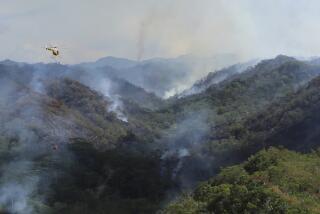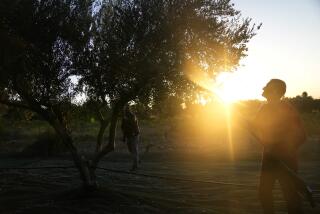In Hawaii, Black Market Branches Out to Koa Tree
HILO, Hawaii — The rising value of koa wood--used for everything from Hawaiian canoes to hand-crafted ukuleles--has led to increasing thefts and a black market for the traditional hardwood, authorities say.
Although no one knows the scope of illegal activity, foresters and state conservation enforcement officials point to recent busts that show an increase in thievery statewide.
A koa tree theft ring was busted on Kauai last year, and a Big Island grand jury issued indictments in a separate case this year.
Authorities said there also have been reports of other recent thefts on Oahu, while state conservation enforcement officers say they are investigating a large case on the Big Island.
“What we’re seeing is just the tip of the iceberg,” said John Holley, a Big Island state conservation enforcement officer.
The koa tree, a native species that grows only in Hawaii, is not considered an endangered, but harvesting is scarce and its value has never been greater.
A mature tree can turn out tens of thousands of dollars worth of finished koa products.
“It’s practically worth its weight in gold,” said Andrea Gill, executive director of the Hawaii Forest Industry Assn.
One reason for the wood’s rising value is its growing scarcity.
The natural range for the trees has diminished over the years because of logging and land-clearing for agricultural production and cattle grazing.
The resource continues to decline under pressure from grazing, an influx of alien plant species and harvesting.
“It’s getting mined like it’s a mineral,” state forester Michael Constantinides said.
Demand for koa far exceeds the supply, which generally is available only on private land, mostly from pastures that contain the remnants of koa forests.
Harvesting on state lands is generally limited to a few areas where those holding permits are allowed to take only trees that have fallen on their own.
The shrinking supply has caused prices to shoot up seven to 10 times in the last 20 years.
“Koa is like a god,” said Mel Pauole, a professional woodworker from Kailua-Kona. “It plays such a big role in the culture. So many people here look upon it as a really special wood.”
Some say the problem is likely to continue because few eyes are watching over Hawaii’s vast koa forests.
On the Big Island, where most of the state’s koa grows, there are about 20 officers responsible for as much as 1 million acres of state Department of Land and Natural Resources territory, plus the ocean extending 12 miles offshore.
In the Kau District, a single officer oversees an area the size of Oahu.
The state Division of Conservation and Enforcement has increased its patrol of prime koa stands and lobbied for legislation that would make it illegal to transport forest products without records detailing where they were obtained.
But protecting the koa forests remains a daunting task.
“We can’t be everywhere,” said Lenny Terlep Sr., the forestry division’s Hilo branch chief. “We’re being used for security at the ports, as escorts in the courts. . . . We rely heavily on tips and good, solid information.”
More to Read
Sign up for Essential California
The most important California stories and recommendations in your inbox every morning.
You may occasionally receive promotional content from the Los Angeles Times.









